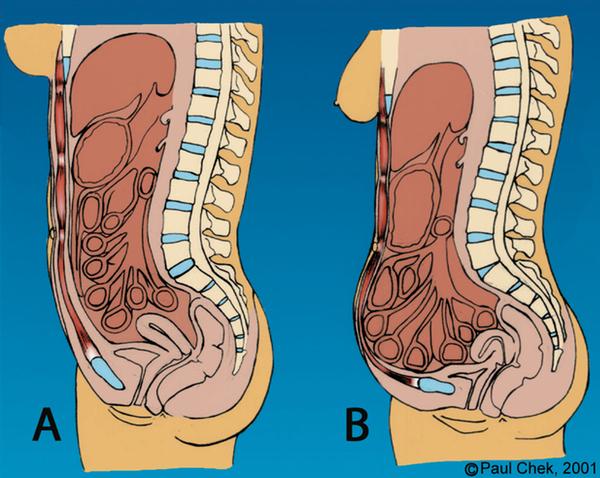Getting Pumped Makes You Feel Good Part 2
by Paul Chek

 In part one of this series, I briefly explained your body’s need for pumping throughout the evolution of human history and introduced the four key bio-pumps (life pumps), muscles that function to cause pressure changes within body cavities.
In part one of this series, I briefly explained your body’s need for pumping throughout the evolution of human history and introduced the four key bio-pumps (life pumps), muscles that function to cause pressure changes within body cavities.
In part 2, you’ll learn how your body’s pumps work in very synergistic ways and how you can avoid constipation with natural pumping movements.
How your pumps work
All of the major pumps, apart from the heart, are intimately related to stabilizing the body, thus they serve a dual function.
In fact, most muscles in the body — including the outer two layers of abdominal musculature — serve a triune function, largely because they are pumps that provide some form of stability and act by moving the body.
To better show you how the stabilizer/pump systems work, let’s use walking as an example. When you walk, there is a series of muscle actions involved in both stabilizing and moving the body, which includes many large muscles in the trunk and extremities, as well as in the inner unit muscles.
 If you view the electromyographic (EMG) recordings of several muscles taken from a subject while walking, you can see the wave-like activity of muscle action followed by brief periods of rest.
If you view the electromyographic (EMG) recordings of several muscles taken from a subject while walking, you can see the wave-like activity of muscle action followed by brief periods of rest.
Note that some muscles become active as stabilizers just prior to a heel strike, while others are more active in moving the body. For example, if you look at the EMG tracings for the rectus abdominis, you can see a definite sinusoidal contraction, which produces alternating phases of contraction and relaxation, generating the pump effect.
When the inner unit muscles contract, pressure increases in the abdominal cavity, moving fluids in the direction of least resistance, which causes flow, much like an old-style water pump. Under the influence of such pumping pressures, blood always flows toward the heart in the venous system, aiding circulation.
Not only do you experience pumping effects from walking, you get them from most any functional movement, albeit unsupported while balancing your own body against gravity. For example, your pumps work when you do simple activities like bending over to pick up an object.
When you are in the gym exercising, be it in an aerobics class, rowing on a rowing machine or performing a squat, you are supporting your physiology.
The king or queen of bio-pumps
Arguably, the king or queen of bio-pumps in your body is the diaphragm. When you are breathing naturally and using your diaphragm correctly, the rib cage expands in three dimensions: Vertically, laterally and anterior/posterior.
As the diaphragm contracts, affording inhalation, a negative pressure is created in the thorax (above the diaphragm) and a positive pressure is created in the abdominal cavity (below the diaphragm). With exhalation, there is a relative reversal of this process.
The pressure changes produced by proper diaphragmatic breathing occur somewhere between 20,000-26,000 times a day, depending on your resting respiratory rate. Those with optimal breathing habits will be on the lower side.
To really appreciate the importance of breathing and your diaphragm as a key bio-pump, imagine how nice it would be if a skilled massage therapist could manually pump muscles and knead the waste fluids out of organs with more 20,000 strokes a day.
Fact is, your body already has a built-in massage therapist if you just breathe naturally (through your nose with your tongue in its natural rest position) allowing your diaphragm full excursion.
The abdominal wall and diaphragm have a very intimate working relationship. The diaphragm is a breathing muscle that assists in stabilization, while the abdominal muscles are stabilizers that assist in respiration.
When you allow your abdominal wall to become weak, uncoordinated and/or distended due to poor dietary, lifestyle and exercise habits, you can compromise the entire bio-pump system!
When the abdominal wall works correctly (Figure A), the internal organs are properly supported and rest in the correct position to maximally benefit from the massage given by diaphragmatic movement.
However, if the abdominal wall becomes dysfunctional (Figure B), the viscera (organs) lose their support and hang from the visceral ligaments, disrupting diaphragmatic excursion, pumping, oxygen transfer and the circulation of most major fluids in the body. That’s not good!
Here’s a very simple and effective way to determine if the functioning of your abdominal wall is compromised. First, stand up and take five or six natural breaths, then judge how much effort it takes to breathe. Then, lie down on the floor (face up) and take another five or six natural breaths, while comparing how much effort it takes for you to breathe in both positions.
If it’s easier for you to breathe while lying on your back than when standing, chances are very good your abdominal wall needs specific testing and conditioning to improve your natural pump actions.
Learn more about testing and exercising the abdominal wall in my Scientific Core Conditioning and Equal But Not The Same correspondence courses. There are many good books on breathing available too, including one of my favorites, Breathe To Succeed In All Aspects Of Your Life by Tania Clifton-Smith.
Fight constipation with natural pumping
Very few people (even those in the healthcare professions) realize that the human being is the only mammal who has to push feces up hill. Once the undigested residues leave the ilium and enter the cecum (the lower right abdominal region where your appendix is located), the fecal remains must be pumped up hill en route to the transverse colon.
Another of the most primal of all human movements, the squat, provides substantial assistance to the colon in this regard.
As you squat into the natural position for defecation in the wild, the right thigh compresses the cecum, assisting fecal material up to the transverse colon, while the left thigh pressurizes the lower descending and sigmoid region, aiding in evacuation.
Next time you are constipated, try doing 15-20 slow, deep squats at breathing pace, breathing out as you lower and in as you raise, always staying as relaxed as possible. You may well find that you can now move your bowel!
Now that you have a basic understanding of how the pump systems work, we’ll look at how the pumps protect your health and well-being by supporting the movement of key bodily fluids in the final part of this series.
Love and chi,
Paul



